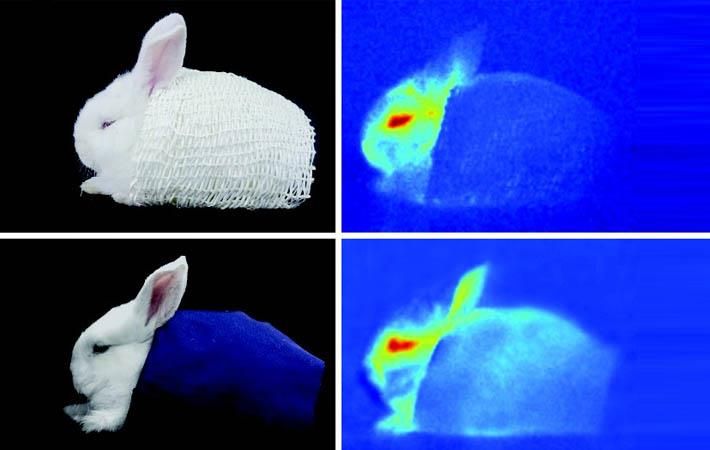Interviews
Chinese scientists make fibres like polar bear hairs
04 Mar '18
3 min read

Courtesy: Chemical & Engineering News
Scientists from Zhejiang University have developed a cloak that makes a bunny almost invisible to infrared cameras, thanks to fibres that mimic the structure of polar bear hairs. The hairs of a polar bear have a hollow core, which reflects back IR emissions from the body. This structure helps prevent heat loss and keeps the bears warm in Arctic environments.
But the hairs have an added advantage: They can conceal the bears from thermal imaging cameras used in many night-vision devices. Textiles that can mimic polar bear hair’s IR-reflecting abilities might be useful in stealth applications, such as concealing soldiers. Previous attempts to make synthetic versions of the hairs have produced fibres that are too weak to be practically useful.
A team from Zhejiang University has now used a freeze-spinning method to make fibres that are porous, strong, and highly thermally insulating. They consist of fibroin, a protein found in silk, along with a small amount of the polysaccharide chitosan.
The researchers slowly squeezed a viscous, watery mixture of these materials through a cold copper ring, forming a frozen fibre that contained flat ice crystals. Freeze-drying the fibres removed the ice by sublimation to produce strong fibres about 200 micrometers wide with up to 87 per cent porosity. After varying conditions such as the viscosity of the mixture and the temperature of the ring, they found that running the process at minus100 degree Celsius produced pores about 30 micrometers across, which offered the best balance between strength and thermal insulation.
“I was surprised to see the thermal conductivity of the biomimetic fibre was even lower than polar bear hair,” says Hao Bai, who led the team.
It’s not the first time that this ice-templating method has been used to make porous fibres, says Sylvain Deville, research director of the Ceramic Synthesis and Functionalisation Laboratory, who uses the method in his own research. But, he says, the team demonstrated good control of the fibre structures.
To demonstrate the thermal stealth potential of the fibres, the researchers wove them into a textile to make a little cape for a live lab rabbit. The critter’s body heat was all but invisible by thermal imaging, whether the background temperature was 40 degree Celsius, 15 degree Celsius or -10 degree Celsius.
As an encore, the Zhejiang team produced an electrically-conductive textile by adding carbon nanotubes to the mixture of fibre precursors. Applying a voltage of 5 V raised the conductive fabric’s temperature from 24 degree Celsius to 36 degree Celsius in less than one minute—not useful for stealth, but potentially helpful for keeping winter clothing cozy. “It’s interesting that they’re able to introduce different materials, so they can combine different functionalities,” Deville says.
Bai has patented the freeze-spinning technique, and hopes to develop the fibre into a commercial product. However, Deville notes that the freeze-spinning process is currently quite slow. “I suspect they will never be able to go very fast, so they may not be able to use it for large-scale applications.” (SV)
But the hairs have an added advantage: They can conceal the bears from thermal imaging cameras used in many night-vision devices. Textiles that can mimic polar bear hair’s IR-reflecting abilities might be useful in stealth applications, such as concealing soldiers. Previous attempts to make synthetic versions of the hairs have produced fibres that are too weak to be practically useful.
A team from Zhejiang University has now used a freeze-spinning method to make fibres that are porous, strong, and highly thermally insulating. They consist of fibroin, a protein found in silk, along with a small amount of the polysaccharide chitosan.
The researchers slowly squeezed a viscous, watery mixture of these materials through a cold copper ring, forming a frozen fibre that contained flat ice crystals. Freeze-drying the fibres removed the ice by sublimation to produce strong fibres about 200 micrometers wide with up to 87 per cent porosity. After varying conditions such as the viscosity of the mixture and the temperature of the ring, they found that running the process at minus100 degree Celsius produced pores about 30 micrometers across, which offered the best balance between strength and thermal insulation.
“I was surprised to see the thermal conductivity of the biomimetic fibre was even lower than polar bear hair,” says Hao Bai, who led the team.
It’s not the first time that this ice-templating method has been used to make porous fibres, says Sylvain Deville, research director of the Ceramic Synthesis and Functionalisation Laboratory, who uses the method in his own research. But, he says, the team demonstrated good control of the fibre structures.
To demonstrate the thermal stealth potential of the fibres, the researchers wove them into a textile to make a little cape for a live lab rabbit. The critter’s body heat was all but invisible by thermal imaging, whether the background temperature was 40 degree Celsius, 15 degree Celsius or -10 degree Celsius.
As an encore, the Zhejiang team produced an electrically-conductive textile by adding carbon nanotubes to the mixture of fibre precursors. Applying a voltage of 5 V raised the conductive fabric’s temperature from 24 degree Celsius to 36 degree Celsius in less than one minute—not useful for stealth, but potentially helpful for keeping winter clothing cozy. “It’s interesting that they’re able to introduce different materials, so they can combine different functionalities,” Deville says.
Bai has patented the freeze-spinning technique, and hopes to develop the fibre into a commercial product. However, Deville notes that the freeze-spinning process is currently quite slow. “I suspect they will never be able to go very fast, so they may not be able to use it for large-scale applications.” (SV)
Fibre2Fashion News Desk – India
Popular News
Leave your Comments
Editor’s Pick
Pratik Gadia
The Yarn Bazaar - Filosha Infotech Private Limited
Andreas Rass
ZIMMER AUSTRIA | Digital Printing Systems
































-Ltd..jpg?tr=w-120,h-60,c-at_max,cm-pad_resize,bg-ffffff)





.jpg?tr=w-120,h-60,c-at_max,cm-pad_resize,bg-ffffff)
.jpg?tr=w-120,h-60,c-at_max,cm-pad_resize,bg-ffffff)






